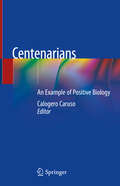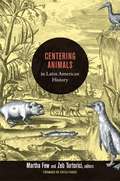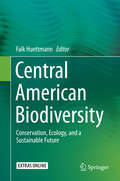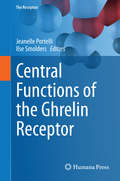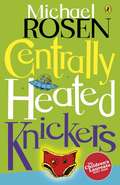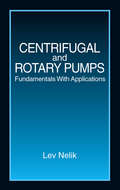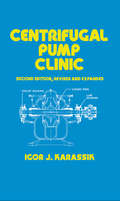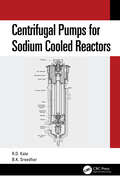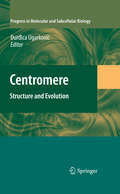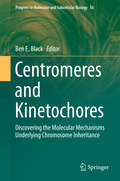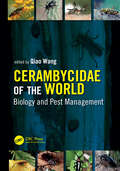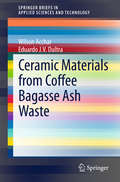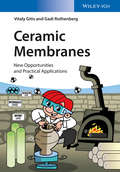- Table View
- List View
Centenarians: An Example of Positive Biology
by Calogero CarusoThis state-of-the-art review on longevity focuses on centenarians, studied as a model of positive biology. The extraordinary rise in the elderly population in developed countries underscores the importance of studies on ageing and longevity in order to decrease the medical, economic and social problems associated with the increased number of non-autonomous individuals affected by invalidating pathologies. Centenarians have reached the extreme limits of human life span. Those in relatively good health, who are able to perform their routine daily tasks, are the best examples of extreme longevity, representing selected individuals in which the appearance of major age-related diseases – including cancer and cardiovascular diseases – has been consistently delayed or avoided. The relationship between causality and chance is an open discussion topic in many disciplines. In particular, ageing, the related diseases, and longevity are difficult to define as a consequence of causality, chance or both. Discussing the relevance of these different factors in the attainment of longevity, the book gathers contributions on genetic, epigenetic and phenotypic aspects of centenarians.The “positive biology” approach is applied to clarify the causes of positive phenotypes, as well as to explain the biological mechanisms of health and well-being with the aim of preventing and/or reducing frailty and disability in the elderly.
Centering Animals in Latin American History
by Martha Few Tortorici ZebCentering Animals in Latin American History writes animals back into the history of colonial and postcolonial Latin America. This collection reveals how interactions between humans and other animals have significantly shaped narratives of Latin American histories and cultures. The contributors work through the methodological implications of centering animals within historical narratives, seeking to include nonhuman animals as social actors in the histories of Mexico, Guatemala, the Dominican Republic, Puerto Rico, Cuba, Chile, Brazil, Peru, and Argentina. The essays discuss topics ranging from canine baptisms, weddings, and funerals in Bourbon Mexico to imported monkeys used in medical experimentation in Puerto Rico. Some contributors examine the role of animals in colonization efforts. Others explore the relationship between animals, medicine, and health. Finally, essays on the postcolonial period focus on the politics of hunting, the commodification of animals and animal parts, the protection of animals and the environment, and political symbolism. Contributors. Neel Ahuja, Lauren Derby, Regina Horta Duarte, Martha Few, Erica Fudge, León García Garagarza, Reinaldo Funes Monzote, Heather L. McCrea, John Soluri, Zeb Tortorici, Adam Warren, Neil L. Whitehead
Centering Gender in the Era of Digital and Green Transition: Intersectional Perspectives
by Adel M. Sarea Amira Kaddour Kristie Drucza Sujata GangulyThis edited volume examines the importance of centering gender in research and policymaking focused on climate change, environmental sustainability, and digital technology. Chapters unpack how the transition to a green and digital future affects various fields and industry sectors including STEM, agriculture, and energy, as well as why gender-transformative approaches—particularly the production and analysis of gender-inclusive disaggregated data—should be included in those transitions. The editors and authors also look at the positive impact of these considerations on economic growth and poverty eradication. Finally, this book presents an ideal/utopian view of what a gender-equal and inclusive world that has transitioned to green industries and embraced digital technologies might look like.This book will be of interest to scholars, researchers, students and policymakers across the Social Sciences including Sociology, Anthropology, Gender Studies, Science & Technology Studies, and Economics.
Centers of Progress: Forty Cities that Changed the World
by Chelsea FollettWhere does progress happen? The story of civilization is the story of the city. It is cities that have created and defined the modern world by acting as the sites of pivotal advances in culture, politics, science, technology, and more. There is no question that certain places, at certain times in history, have contributed disproportionately toward making the world a better place. This book tells the story of 40 of those places. <p><p>In Centers of Progress: 40 Cities That Changed the World, Chelsea Follett examines a diverse group of cities, ranging from ancient Athens to Song-era Hangzhou. But some common themes stand out: most cities reach their creative peak during periods of peace; most centers of progress also thrive during times of social, intellectual, and economic freedom, as well as openness to intercultural exchange and trade; and centers of progress tend to be highly populated. Because, in every city, it is ultimately the people who live there who drive progress forward―if given the freedom to do so. <p><p>Identifying common factors―such as relative peace, freedom, and multitudes―among the places that have produced history's greatest achievements is one way to learn what causes progress. Change is a constant, but progress is not. Understanding what makes a place fertile ground for progress may help to sow the seeds of future innovations. <p><p>Moreover, their story is our story. City air provides the wind in the sails of the modern world. Come journey through these pages to some of history's greatest centers of progress.
Central American Biodiversity: Conservation, Ecology, and a Sustainable Future
by Falk HuettmannThis book highlights key results and lessons learnt from two field sites, La Suerte in Costa Rica and Ometepe Nicaragua. It provides long term data on species abundance and distribution. Primates receive specific attention in this book, as they are flagship species and good indicators for the "health" of an ecosystem, but as well a money maker. Many primate species are sensitive to habitat alteration, and are often hunted out first. But they play an important role as seed dispersal agents for the regeneration of the forest. The book then compares results from the two field sites with regional trends, and explores potential solutions such as REDD+. This book strongly calls for new approaches in conservation, it makes the case for looking beyond the pure species biology and classic conservation angle and to take into account the economic and political realities.
Central European Stream Ecosystems: The Long Term Study of the Breitenbach
by Eileen J. Cox Peter Zwick Jürgen Marxsen WagnerProbably the best-studied stream on earth. The result of unmatched long-term data taken by the Max-Planck outstation in Schlitz from the nearby Breitenbach stream since 1949, the special focus in this handbook and ready reference is on animal and microorganism occurrence and variation, as well as chemical and physical parameters. An invaluable data basis for modeling purposes for anyone dealing with stream ecology.
Central Functions of the Ghrelin Receptor (The Receptors #25)
by Jeanelle Portelli Ilse SmoldersThe Ghrelin receptor was identified before its natural ligand ghrelin. This receptor is found both centrally and peripherally, and has been shown to affect various processes, such as food intake, gut motility, memory, glucose and lipid metabolism, cardiovascular performances, reproduction, memory, and immunological responses, amongst others. The functions of the ghrelin receptor in the central nervous system are numerous and are still being explored. In this book we specifically focus on the various roles of the ghrelin receptor in the central nervous system. In a first set of chapters, the book will focus on the discovery and the properties of this intriguing constitutively active G-protein coupled receptor, on its multiple intracellular transduction mechanisms and the various subtypes of the currently known ghrelin receptor complexes. Next, the book will elaborate on the mitochondrial mechanisms regulated by the ghrelin receptor, its role in feeding and drug addictive mechanisms, memory, sleep and arousal. The final chapters focus on the potential of this receptor as a target for the treatment of neurological disorders including Parkinson's disease, epilepsy, anxiety and depression.
Central Nervous System Metastasis, the Biological Basis and Clinical Considerations (Cancer Metastasis - Biology and Treatment #18)
by Diane PalmieriHere is a thorough survey of the biology and treatment of CNS metastasis, including natural history, risk factors, molecular biology, the blood-brain barrier, imaging, quality of life, surgery, chemotherapy, radiation and the future of targeted therapies.
Central Park Zoo, The
by Joan ScheierCountless New Yorkers, as well as visitors from all parts of the world, have experienced an oasis just a few feet off Fifth Avenue in the heart of Manhattan. Since the 1860s, Central Park has been the home of three different zoos: the menagerie, the zoo of 1934, and what is today known as the Central Park Zoo. The Central Park Zoo begins with the menagerie of the 1860s, an impromptu public zoo begun when citizens and circuses started donating animals to the city. It continues in 1934, when Robert Moses-perhaps the most influential man in the city's planning history-built a newer zoo, remembered to this day for its lions, tigers, elephants, and gorillas. It ends with the brand new zoo and exhibits built in 1988 under the supervision of the Wildlife Conservation Society. With stunning, rarely seen images, The Central Park Zoo not only is a treat for the eyes but also comes alive with the barking of sea lions, the soft fur of snow monkeys, the sweet smell of peanut butter, and the taste of "ice cakes"-treats for the zoo residents, of course.
Central Regulation of Energy Metabolism With Special Reference To Circadian Rhythm
by Katsuya NagaiThis excellent book describes the roles of the suprachiasmatic nucleus (SCN) of the hypothalamus as a regulatory center of homeostatic mechanism and a circadian oscillator in mammals, including humans. The authors emphasize two important points based on their findings: 1) SCN plays a critical role in central regulation of energy metabolism through which a constant supply of glucose to the central nervous system (CNS) is well maintained; and 2) neurons responsible for the regulation of energy metabolism are located in the ventrolateral part of the SCN and receive retinal neural inputs through both the retinohypothalamic tract and the geniculohypothalamic tract. The authors then discuss the evolutionary importance of these points to the survival of mammals on earth. Other topics examined include the involvement of light in the regulation of neural activity of the autonomic nervous system through the retina and SCN, in addition to the relation of the SCN with regulations of other autonomic nerve functions, such as blood pressure and body temperature. Central Regulation of Energy Metabolism with Special Reference to Circadian Rhythm is important reading for researchers and students in neuroendocrinologists, neurobiologists, biochemists, endocrinologists, physiologists, chronobiologists, psychologists, pharmacologists, and others interested in the topic.
Centrally Heated Knickers
by Michael RosenHail! Hail!I come from anothergalaxy.Discover the wierd and wonderful world of martians, woolly saucepans and centrally heated knickers in 100 poems about science and technology from the delightfully irreverent, Michael Rosen, Children's Laureate 2007 - 2009.
Centrifugal & Rotary Pumps: Fundamentals With Applications
by Lev NelikCentrifugal and Rotary Pumps offers both professionals and students a concise reference detailing the design, performance, and principles of operation of the different pumps types defined by the Hydraulic Institute. From historical background to the latest trends and technological developments, the author focuses on information with real-world prac
Centrifugal Pump Clinic, Revised and Expanded (Mechanical Engineering #68)
by Igor J. KarassikMaintaining the excellent coverage of centrifugal pumps begun in the First Edition -- called ``useful'' and ``indispensable'' by reviewers -- the Second Edition continues to serve as the most complete and up-to-date working guide yet written for plant and design engineers involved with centrifugal pumps.
Centrifugal Pumps for Sodium Cooled Reactors
by Ravindra Kale B.K. ShreedharThis comprehensive introduction to centrifugal pumps used in sodiumcooled fast reactors discusses the special attributes of centrifugal pumps, design features, manufacturing requirements, instrumentation, and operating experience. It covers the characteristics of mechanical pumps, used as the main coolant pumps in fast reactors. Key Features: • Covers description of pumps in various reactors highlighting the special features of the pumps and providing an overview of futuristic design concepts. • Discusses the aspects related to the design, manufacture, testing, instrumentation, and operating experience of centrifugal sodium pumps. • Highlights the challenges in centrifugal sodium pump testing. • Presents topics such as cavitation testing for critical applications and thermodynamic effect on pump cavitation. • Real-life case studies are included for better understanding. This book gives a detailed overview of the design, manufacture, testing, and operating experience of the main coolant pumps used in sodium-cooled nuclear reactors. It further discusses the special type of pumps used in fast reactor power plants to circulate liquid sodium through the core. The text examines the challenges in centrifugal sodium pump testing and types of test facilities around the world. Real-life examples are used to highlight important aspects. It is primarily written for senior undergraduate, graduate students, and academic researchers in the fields such as mechanical engineering, nuclear engineering, and chemical engineering.
Centromere: Structure and Evolution (Progress in Molecular and Subcellular Biology #48)
by Durdica UgarkovicThe centromere is a chromosomal locus that regulates the proper pairing and segregation of the chromosomes during cell division. Despite their conserved, essential function, centromeres are characterized by the rapid evolution of both centromeric DNA and proteins. This book presents current views on centromere structure and identity. It deals with the epigenetic concept of centromere establishment and maintenance as well as with the role of DNA and centromeric transcripts in centromere formation and function. Special emphasis is placed on centromere evolution: different evolutionary models are discussed in detail and the latest research on the evolution of new centromeres and neocentromeres is presented.
Centromeres and Kinetochores: Discovering the Molecular Mechanisms Underlying Chromosome Inheritance (Progress in Molecular and Subcellular Biology #56)
by Ben E. BlackThis book presents the latest advances concerning the regulation of chromosome segregation during cell division by means of centromeres and kinetochores. The authors cover both state-of-the-art techniques and a range of species and model systems, shedding new light on the molecular mechanisms controlling the transmission of genetic material between cell divisions and from parent to offspring. The chapters cover five major areas related to the current study of centromeres and kinetochores: 1) their genetic and epigenetic features, 2) key breakthroughs at the molecular, proteomic, imaging and biochemical level, 3) the constitutive centromere proteins, 4) the role of centromere proteins in the physical process of chromosome segregation and its careful orchestration through elaborate regulation, and 5) intersections with reproductive biology, human health and disease, as well as chromosome evolution. The book offers an informative and provocative guide for newcomers as well as those already acquainted with the field.
Cephalopod Behaviour (2nd Edition)
by Roger T. Hanlon John B. MessengerWith their large brains, elaborate sense organs and complex behaviour, cephalopods are among the world’s most highly evolved invertebrates. This second edition summarises the wealth of exciting new research data stemming from over 500 papers published since the first volume appeared. It adopts a comparative approach to causation, function, development and evolution as it explores cephalopod behaviour in natural habitats and the laboratory. Extensive colour and black-and-white photography illustrates various aspects of cephalopod behaviour to complement the scientific analysis. Covering the major octopus, squid and cuttlefish species as well as the shelled Nautilus, this is an essential resource for undergraduate and advanced students of animal behaviour, as well as researchers new to cephalopods, in fields such as neuroscience and conservation biology. By highlighting the gaps in current knowledge, the text looks to inform and to stimulate further study of these beautiful animals.
Cephalopod Cognition
by Anne-Sophie Darmaillacq Ludovic Dickel Jennifer Mather Anne-Sophie Darmaillacq Ludovic DickelCephalopods are generally regarded as the most intelligent group among the invertebrates. Despite their popularity, relatively little is known about the range and function of their cognitive abilities. This book fills that gap, accentuating the varied and fascinating aspects of cognition across the group. Starting with the brain, learning and memory, Part I looks at early learning, memory acquisition and cognitive development in modern cephalopods. An analysis of the chambered nautilus, a living fossil, is included, providing insight into the evolution of behavioural complexity. Part II surveys environmental responses, especially within the active and learning-dependent coleoids. The ever-intriguing camouflage abilities of octopus and cuttlefish are highlighted, alongside bioluminescence, navigation and other aspects of visual and cognitive competence. Covering the range of cognitive function, this text underscores the importance of the cephalopods within the field of comparative cognition generally. It will be highly valuable for researchers, graduates and senior undergraduate students.
Cephalopod Culture
by José Iglesias Lidia Fuentes Roger VillanuevaCephalopod Culture is the first compilation of research on the culture of cephalopods. It describes experiences of culturing different groups of cephalopods: nautiluses, sepioids (Sepia officinalis, Sepia pharaonis, Sepiella inermis, Sepiella japonica Euprymna hyllebergi, Euprymna tasmanica), squids (Loligo vulgaris, Doryteuthis opalescens, Sepioteuthis lessoniana) and octopods (Amphioctopus aegina, Enteroctopus megalocyathus, Octopus maya, Octopus mimus, Octopus minor, Octopus vulgaris, Robsonella fontaniana). It also includes the main conclusions which have been drawn from the research and the future challenges in this field. This makes this book not only an ideal introduction to cephalopod culture, but also a valuable resource for those already involved in this topic.
Cerambycidae of the World: Biology and Pest Management (Contemporary Topics in Entomology)
by Qiao WangWang has gathered contributions from an impressive cohort of the world’s most respected experts on longhorned beetles. Chapters review both basics of cerambycid taxonomy, mor- phology, and behavior (feeding, reproduction, and chemical ecology), as well as more applied concerns, such as laboratory rearing, pest control, and bio- security. Overall, this volume is a valuable contribution to the literature as a "one-stop shop" for readers seeking a comprehensive overview of longhorned beetles... It represents a tremendous effort on the part of Wang and the authors, and has resulted in a much-needed update to the literature. This volume is the only work of its kind available at this time, and is a valuable addition to the library of any scientist studying wood-boring beetles. - Ann M. Ray, Biology, Xavier University, Cincinnati, Ohio in The Quarterly Review of Biology, Volume 94, 2019 There are more than 36,000 described species in the family Cerambycidae in the world. With the significant increase of international trade in the recent decades, many cerambycid species have become major plant pests outside their natural distribution range, causing serious environmental problems at great cost. Cerambycid pests of field, vine, and tree crops and of forest and urban trees cost billions of dollars in production losses, damage to landscapes, and management expenditures worldwide. Cerambycidae of the World: Biology and Pest Management is the first comprehensive text dealing with all aspects of cerambycid beetles in a global context. It presents our current knowledge on the biology, classification, ecology, plant disease transmission, and biological, cultural, and chemical control tactics including biosecurity measures from across the world. Written by a team of global experts, this book provides an entrance to the scientific literature on Cerambycidae for scientists in research institutions, primary industries, and universities, and will serve as an essential reference for agricultural and quarantine professionals in governmental departments throughout the world.
Ceramic Materials from Coffee Bagasse Ash Waste (SpringerBriefs in Applied Sciences and Technology)
by Wilson Acchar Eduardo J. V. DultraThis book proposes the use of coffee bagasse ash (CBA) waste as raw material to be used in ceramic formulations. The approach presented here is a solution to a current ambiental problem as CBA waste is discharged in high amounts in agriculture. The authors analyze the potencial of CBA as a material to substitute feldspar in tile production.
Ceramic Materials: Science and Engineering
by C. Barry Carter M. Grant NortonCeramic Materials: Science and Engineering is an up-to-date treatment of ceramic science, engineering, and applications in a single, comprehensive text. Building on a foundation of crystal structures, phase equilibria, defects, and the mechanical properties of ceramic materials, students are shown how these materials are processed for a wide diversity of applications in today's society. Concepts such as how and why ions move, how ceramics interact with light and magnetic fields, and how they respond to temperature changes are discussed in the context of their applications. References to the art and history of ceramics are included throughout the text, and a chapter is devoted to ceramics as gemstones. This course-tested text now includes expanded chapters on the role of ceramics in industry and their impact on the environment as well as a chapter devoted to applications of ceramic materials in clean energy technologies. Also new are expanded sets of text-specific homework problems and other resources for instructors. The revised and updated Second Edition is further enhanced with color illustrations throughout the text.
Ceramic Matrix Composites
by Narottam P. Bansal Jacques LamonThis book is a comprehensive source of information on various aspects of ceramic matrix composites (CMC). It covers ceramic and carbon fibers; the fiber-matrix interface; processing, properties and industrial applications of various CMC systems; architecture, mechanical behavior at room and elevated temperatures, environmental effects and protective coatings, foreign object damage, modeling, life prediction, integration and joining. Each chapter in the book is written by specialists and internationally renowned researchers in the field. This book will provide state-of-the-art information on different aspects of CMCs. The book will be directed to researchers working in industry, academia, and national laboratories with interest and professional competence on CMCs. The book will also be useful to senior year and graduate students pursuing degrees in ceramic science and engineering, materials science and engineering, aeronautical, mechanical, and civil or aerospace engineering.Presents recent advances, new approaches and discusses new issues in the field, such as foreign object damage, life predictions, multiscale modeling based on probabilistic approaches, etc.Caters to the increasing interest in the application of ceramic matrix composites (CMC) materials in areas as diverse as aerospace, transport, energy, nuclear, and environment. CMCs are considered ans enabling technology for advanced aeropropulsion, space propulsion, space power, aerospace vehicles, space structures, as well as nuclear and chemical industries.Offers detailed descriptions of ceramic and carbon fibers; fiber-matrix interface; processing, properties and industrial applications of various CMC systems; architecture, mechanical behavior at room and elevated temperatures, environmental effects and protective coatings, foreign object damage, modeling, life prediction, integration/joining.
Ceramic Membranes: New Opportunities and Practical Applications
by Gadi Rothenberg Vitaly GitisWritten by two internationally renowned authors in the sciences and engineering to ensure a multidisciplinary approach, this is the essential textbook on a growing field that is increasingly finding industrial applications. Following an introduction to ceramic membranes, the text goes on to treat the fundamentals of membrane separation, followed by an overview of characterization techniques, applications, and the economics. Each chapter ends with qualitative and quantitative exercises, as well as around 150 literature references. An accompanying website features solutions to selected exercises, as well as PowerPoint slides of all of the figures in the book, and a full list of all references complete with their DOIs. Since membrane processes are usually taught either at the end of the undergraduate degree or during graduate studies, this textbook is aimed at both senior undergraduates and graduate researchers.
Ceramic Processing: Industrial Practices
by Debasish SarkarThis book gives a comprehensive account on the manufacturing techniques to synchronize the desired properties of both traditional and advanced ceramics. Offers exclusive and up to date information on industrial ceramic processing equipment and approaches and discusses actual industrial practices taking a product-oriented approach It should serve as a text to answer the processing of ceramics and achieve targeted product in industrial environment.
